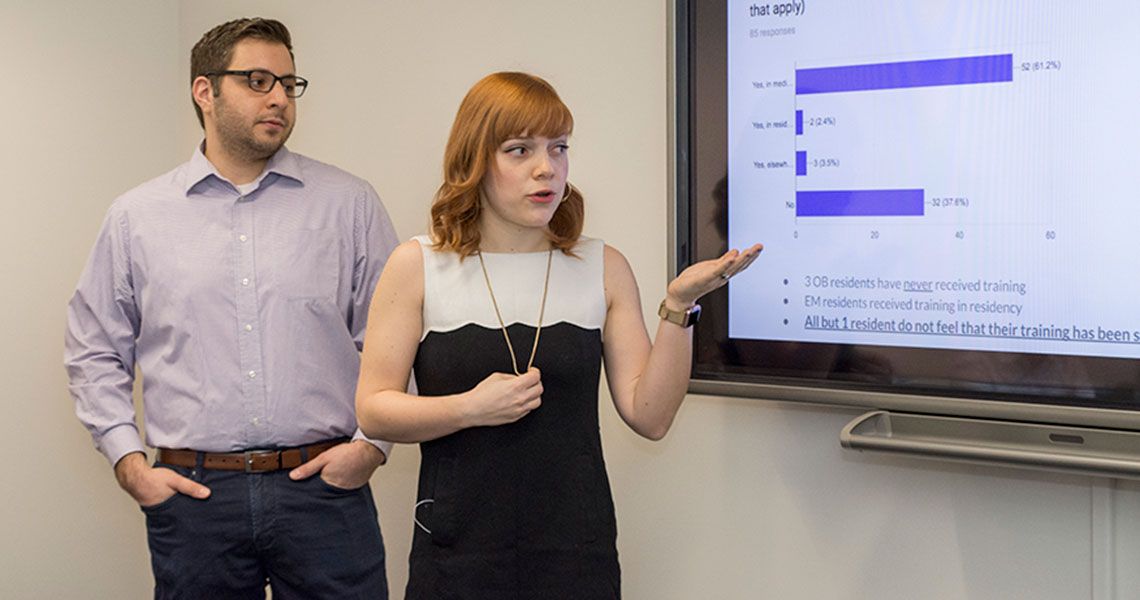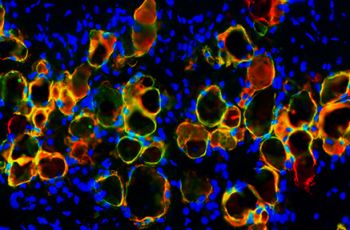During their third-year OB/GYN rotation, a group of medical students at the George Washington University (GW) School of Medicine and Health Sciences filtered through the mock-exam rooms of the CLASS Center. The standardized patients, or “SPs,” they met – actors taking on temporary daytime roles – discussed typical maladies and conditions an OB/GYN would potentially diagnose. One patient, however, was different. This SP was a sexual assault survivor.
“That one single SP encounter [stood out] because I was so caught off-guard,” recalls Billy Vintzileos, now a fourth-year medical student. He and the cluster of students who worked with the SP came away feeling unsettled and wanted to learn how to do more to help sexual assault survivors.
“It was a curveball,” explains Rebecca Surrey, fourth-year MD student. “Now as residents, we’re going to be the ones to provide that medical care, and we are the ones people ask for help, so we should know what to do.”
Motivated by the opportunity to enrich training for future classes, Surrey and Vintzileos – along with classmates Anjali Cera, Michael Frangieh, Mollie Kotzen, Laura Haworth, and Natalie Mandel – seized on the topic of sexual assault training for medical providers, primarily through curriculum implementation, for their Clinical Public Health Summit project.
The year-long projects, explains Lawrence “Bopper” Deyton, MD ’85, MSPH, senior associate dean for clinical public health and Murdock Head Professor of Medicine and Health Policy, build on the summits that students participate in throughout their first three years of medical school. The goal, he says, is for students to learn how, as clinicians, they can take active roles in public and community health issues to tackle complex problems, such as childhood asthma, obesity, and HIV/AIDS. They are tasked with creating solutions and presenting them to experts, sometimes with real consequences; student proposals from the 2015 HIV/AIDS summit, for example, were included in Washington, D.C.’s new HIV/AIDS Action Plan.
It was the students, as well, who proposed picking their own topics for their culminating Clinical Public Health Summit; Deyton said yes.
“To be able to choose a topic, particularly one in their chosen specialty, and work on it for a full year has particular salience for the rest of their careers,” he explains. “I thought the topics the students chose were fascinating and exciting. It showed me that our students have learned how to be great clinicians who can take care of individual patients and [that they are] also clinicians who can identify and act on broader factors that happen outside of the doctor’s office or hospital that will improve community health.”
Topics ranged from traumatic brain injuries in children to the opioid crisis, and individual projects were, in large part, sparked by personal experiences.
Emmeline Ha, for example, whose project focused on Hepatitis B and C clinical practice guidelines for immigrant populations, “personally had family affected by the disease. I felt like it was really an important issue that health providers should be involved in, and the project was an accumulation of my work in the past four years.”
She volunteered at screening events for more than 600 patients in the Washington, D.C., Mongolian community, and found a prevalence of Hepatitis B or C in 12 percent. “For such a small community, that’s a very stark difference compared to the general population,” she explains. Ha would like to see the guidelines updated to account for foreign-born patients who could be vulnerable to the disease.
Cate Mackenzie, a nurse before medical school, wanted to build on her experience keeping patients mobile. “We know that’s really important for patients to prevent complications of hospitalization,” she says. “There’s a rule of thumb that for people over the age of 65, every day in bed requires about a week of recovery to get back to their baseline.”
Her interventions include mobility boards for both patients and providers in hospital rooms, adding more handrails in the hallways of GW Hospital, and training medical students how to mobilize patients. “Starting this April, that will be part of getting ready [for] the wards – students will learn how to do that.”
Education was also a critical part of Mary Piechowiak’s project. Climate change, she says, can directly impact health; an increase in temperature, for instance, is linked to more kidney stones and can negatively affect outcomes in patients with diabetes, cardiovascular disease, and obesity. Professional medical organizations have issued statements on the correlation, and the American College of Physicians offers a toolkit, but, she says, “in medical education, there isn’t a lot of incorporation of climate change.”
Her aim, inspired by her participation in last year’s Women’s March and the March for Science, is to enact change from the ground up. She’s gathering potential data on folding climate change into the medical curriculum, and she’s hoping to meet with leadership once her research is complete.
“A year ago, I knew a little bit, but compared to now, I didn’t know anything about how climate change affects health. I hope it gets into the curriculum,” she says. “One of the things I’m planning to do is come up with my own little PowerPoint so that next year when I go into residency… I want to have something I can share with my peers and teach them about climate change.”
Dave Falk and his classmates, Sachin Gupta, Michael Hoy, and Thomas Lynch, are likewise gathering data for their project. Inspired by his time before medical school as an adaptive ski instructor for those with disabilities, Falk thought “it would be a unique opportunity to incorporate my interest in adaptive sports with veterans with my future career as an orthopedic surgeon.”
Adaptive sports, he explains, have a number of benefits – improving self-esteem and self-image, for example – but there’s a “dearth of literature.” Through surveys, the foursome is looking at what organizational factors those with disabilities, particularly veterans, look for when getting involved in sports and how to grow participation. Their project is currently in IRB review, and they’re hoping third-year students will continue the project in their stead.
The presentations, says Kaylan Baban, MD, MPH, assistant professor of medicine and lead faculty of the summit, were, in some ways, sales pitches to third-year students – who are now starting their own culminating year-long projects – to keep the momentum, as well as inspiring.
“The critical thinking, enthusiasm, and passion that these students put into their projects and brought to their presentations was fantastic to see.”
As Baban says, an interest in public health shouldn’t be limited to specialty – family medicine and internal medicine are the traditional companions to public health – and all clinicians should aim to make a difference outside of the exam room.
“It’s absolutely universal. There is no specialty that does not have areas of significant relevance for our broader public health conversation. It’s thrilling to see this understanding taking root in real time, and hopefully the relevance of clinical public health for specialties across the board will not even be a second thought for these students in the future.”



